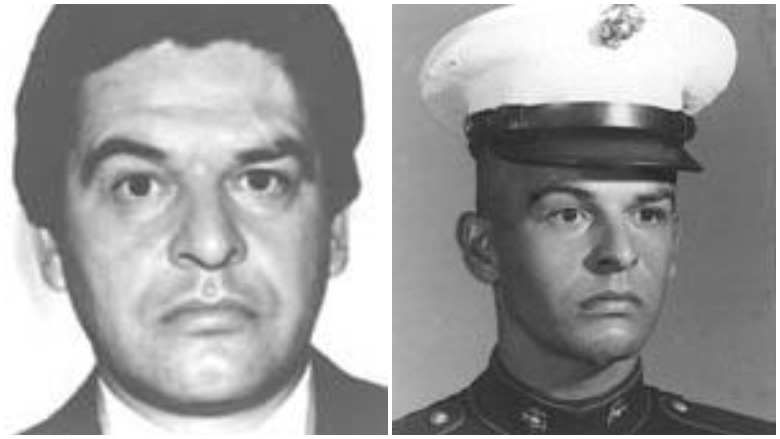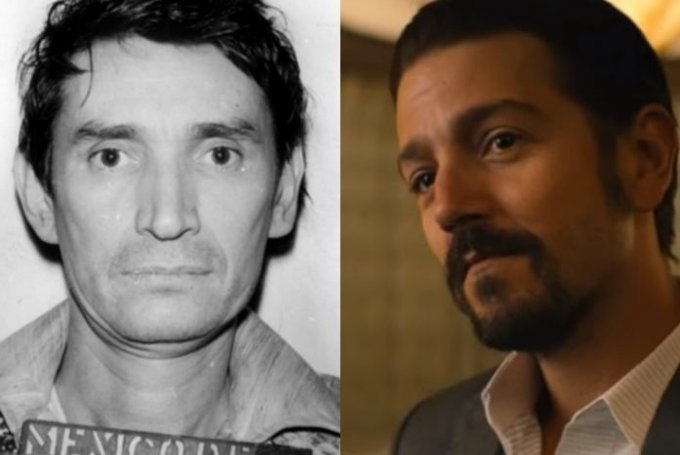
Getty Felix Gallardo is played by Diego Luna in Narcos: Mexico
Felix Gallardo played a key role in the formative years of Mexico’s cartels. He wanted to do the seemingly impossible: Unite Mexico’s warring drug factions into a single cartel. (Warning: This article contains spoilers for the Netflix series Narcos: Mexico because it closely follows true events.)
This, Gallardo accomplished, but he and his men made a fatal mistake (fueled by factions in the Mexican government, which were aligned with the CIA): They committed what was considered a deep affront to the United States government, drawing heavy media attention, by torturing and murdering a DEA agent. The rise – and fall – of Felix Gallardo is chronicled in seasons 1 and 2 of the Netflix series, Narcos: Mexico.
It picks up where the past seasons left off, moving the setting from Colombia (and Pablo Escobar and the Cali Cartel) to Guadalajara, where Gallardo built the first Mexican cartel. (You can see photos of the real people behind the Narcos: Mexico characters here.) The beginning of Season 2 shows Gallardo still in power but dealing with the fallout of citizen pressure against political leaders.
Gallardo’s full name was Miguel Angel Felix Gallardo. He was a real person. In real life, he was called “El Padrino” (The Godfather.) He’s played by actor Diego Luna in Narcos: Mexico. In the final episode of Narcos: Mexico‘s first season, he’s escaped justice and is free to pick back up the pieces of his drug trafficking organization. In season 2, he does just that, but his downfall looms (and, sure enough, right away in episode 1 of season 2, we see a glimpse of a Gallardo hanger-on…. named El Chapo.) What’s the true story of Felix Gallardo? Where is he today?
Here’s what you need to know:
The Death of Kiki Camarena Was Felix Gallardo’s Downfall
First of all, let’s cut to the chase. Felix Gallardo is still alive. However, he was eventually captured. It took authorities five years to find him, though. When Narcos Mexico 2 streamed in February 2020, Gallardo was 74 years old and still incarcerated.
Where is he today? He’s serving a 37-year sentence in a Mexican maximum-security prison. He’s been in prison since 1989, when he was captured in his bathrobe in what is known as Operation Leyenda. He had been sought since the death of Kiki Camarena, but he evaded authorities for five years.
By 2011, Gallardo’s family told a Mexican court that his health was failing. According to The Washington Post, the family members claimed Felix Gallardo has “cataracts, deafness, ulcers and a hernia.” (You can read more about the real Kiki Camarena here.)
“For more than three years, without any justification, prison authorities have kept him segregated, isolated and without contact with other inmates, and have prevented him from participating in any physical, sports or educational activities,” the drug lord’s family wrote to the court, The Post reported.
According to Express, he was “transferred to a medium-security prison in 2014 due to his declining health.”
Narcos: Mexico revolves around the intersection of two real-life characters: Felix Gallardo and the U.S. Drug Enforcement Administration agent, Kiki Camarena, who was on his trail. The Camarena tragedy is legendary. Then, season 2 deals with the after-effects of the cartel’s disastrous decision to take out a DEA agent, igniting the American war on drugs in a new way.
How brutal was Felix Gallardo during his prime? According to The Post, “he is reputed to have punished a subordinate’s alleged betrayal by killing the subordinate’s children, cutting off the head of his wife, and sending the head to him in a box.”
In the show, the wily but ruthless Gallardo manages to piece together a cartel out of mortal enemies and rogue drug groups. However, Camarena, a DEA agent who’s relocated to Mexico, is on his trail – in the days when the U.S. government pretty much turned a blind eye to the Mexican drug trade (and the CIA had other priorities). The DEA was headquartered over a strip club.
Camarena opens the show in a scene that shows he’s been abducted. Kiki Camarena was born Enrique (Kiki) S. Camarena on July 26, 1947, in Mexicali, Mexico. He was raised in California, where he was a U.S. Marine, a police officer, and a firefighter, according to a DEA biography of him.

DEAKiki Camarena
By 1985, which is when Narcos: Mexico roughly starts, “he was extremely close to unlocking a multi-billion dollar drug pipeline,” the DEA says. He was about to expose the operation when he was kidnapped on February 7 while he went to have lunch with his wife, Mika.
“Kiki was surrounded by five armed men who threw him into a car and sped away. That was the last time anyone but his kidnappers would see him alive,” reveals the DEA, adding that he likely died two days later.
In March 1985, the DEA recovered the body of Kiki Camarena, 37. According to El Pais, Camarena’s “skull, jaw, nose and cheekbones were crushed with a tire iron. As he lay dying, a cartel doctor was ordered to keep him alert by administering drugs.”
According to The Los Angeles Times, Camarena’s murder “led to the fall of Gallardo and his close associates” and the fracturing of their cartel.
Amazingly, Gallardo was only recently re-sentenced in the death. Gallardo was sentenced to 37 years in 2017 for the death of Camarena by a Mexican court (as well as for the murder of Alfredo Zavala, a Mexican pilot), according to The Times. He’s been in custody since 1989; however, a retrial had been ordered. Zavala was helping Camarena in his “undercover operations,” The LA Times reported. He was originally sentenced to 40 years in prison in the Camarena death. Key figures in the Camarena death had filed appeals of their sentences. Gallardo was ordered to pay about $1.17 million in reparations, according to The Associated Press.
The Times noted that the bodies appeared to have been tortured and were found near a ranch in Michoacan state. Ernesto “Don Neto” Fonseca and Rafael Caro Quintero were other cartel leaders involved. Today, Fonseca is on house arrest, and Caro Quintera was “released from prison in 2013 on a legal technicality” and is being sought by the U.S.
“We coordinated with the Mexican national police … and we started to do wire intercepts and we tracked him to a residence in Guadalajara — he never left Guadalajara, that was his power base,” Mike Vigil, former chief of international operations for the DEA, told Business Insider, of the capture of Gallardo.
Camarena’s death changed the face of Mexican drug cartels. This became the reality of the “drug war” that ignited: Take one thing out, and another thing fills the vacuum – and sometimes it’s something worse. The implosion of Guadalajara led to the rise of the Sinaloa cartel, led by Joaquin “El Chapo” Guzman, who is now in U.S. custody.
The bottom line: Gallardo’s cartel went too far by targeting Camarena (the series highlights the Mexican government’s controlling role in the matter, but, in the end, it’s Gallardo who orders the final deed). The Reagan Administration predictably freaked out when the media got involved and exercised its power. The U.S./Mexican border almost shut down. It was eventually his end (although it took five years to find him), and his new cartel’s end, and it was El Chapo’s beginning (the eventual drug lord is first seen in the beginning of Narcos: Mexico in all his humble beginnings as a driver for a Sinaloan drug lord). The “drug war” as we know it today cemented.

Mexican drug trafficker Joaquin Guzman Loera aka “el Chapo Guzman” (C), is escorted by marines as he is presented to the press on February 22, 2014 in Mexico City. The Sinaloa cartel leader – the most wanted by US and Mexican anti-drug agencies – was arrested by Mexican marines at a resort in Mazatlan, northern Mexico.
A 1989 New York Times article on Gallardo’s arrest says that authorities also rounded up an entire city police force for questioning about ties to him. It’s true that Gallardo was close to a Mexican governor, Antonio Toledo Corro, according to The Times, and was photographed at a wedding with him.
According to the book U.S. Border Security: A Reference Handbook, by Judith Ann Warner, Felix Gallardo started working as a family bodyguard for Mexican Governor Leopoldo Sanchez Celis. Gallardo was able to use those connections to build his cartel. Gallardo was a godfather to Celis’s son, who was murdered and tortured by a rival cartel. He was once a federal police agent and was born on a Sinaloan ranch. He was also a supporter of the Contras, a point that some have used to allege led the U.S. government to look the other way before the Camarena murder.
In later years, James Kuykendall, the DEA supervisor of Camarena in Guadalajara, has spoken out about the CIA and the Kiki Camarena murder. Kuykendall is quoted in the book Whiteout: The CIA, Drugs, and the Press by Alexander Cockburn. The book alleges that DEA officers investigating Camarena’s death “knew that the drug agent’s murder was a joint operation between the drug cartel and the DFS, an agency with intimate ties to the CIA.”
Kuykendall said, “The CIA didn’t give a damn about anything but Cuba and the Soiets. Indirectly, they (the CIA) have got to take some of the blame.” He alleged the CIA “protected the DFS for decades,” and stated “The DFS just got out of hand.”
READ NEXT: Where Is Don Neto Today?

Comments
Felix Gallardo Today: Where Is the Cartel Leader Now?